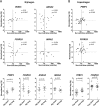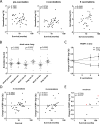Survival of metastatic melanoma patients after dendritic cell vaccination correlates with expression of leukocyte phosphatidylethanolamine-binding protein 1/Raf kinase inhibitory protein
- PMID: 28978044
- PMCID: PMC5620184
- DOI: 10.18632/oncotarget.18698
Survival of metastatic melanoma patients after dendritic cell vaccination correlates with expression of leukocyte phosphatidylethanolamine-binding protein 1/Raf kinase inhibitory protein
Abstract
Immunotherapy for metastatic melanoma offers great promise but, to date, only a subset of patients have responded. There is an urgent need to identify ways of allocating patients to the most beneficial therapy, to increase survival and decrease therapy-associated morbidity and costs. Blood-based biomarkers are of particular interest because of their straightforward implementation in routine clinical care. We sought to identify markers for dendritic cell (DC) vaccine-based immunotherapy against metastatic melanoma through gene expression analysis of peripheral blood mononuclear cells. A large-scale microarray analysis of 74 samples from two treatment centers, taken directly after the first round of DC vaccination, was performed. We found that phosphatidylethanolamine binding protein 1 (PEBP1)/Raf Kinase inhibitory protein (RKIP) expression can be used to identify a significant proportion of patients who performed poorly after DC vaccination. This result was validated by q-PCR analysis on blood samples from a second cohort of 95 patients treated with DC vaccination in four different centers. We conclude that low PEBP1 expression correlates with poor overall survival after DC vaccination. Intriguingly, this was only the case for expression of PEBP1 after, but not prior to, DC vaccination. Moreover, the change in PEBP1 expression upon vaccination correlated well with survival. Further analyses revealed that PEBP1 expression positively correlated with genes involved in T cell responses but inversely correlated with genes associated with myeloid cells and aberrant inflammation including STAT3, NOTCH1, and MAPK1. Concordantly, PEBP1 inversely correlated with the myeloid/lymphoid-ratio and was suppressed in patients suffering from chronic inflammatory disease.
Keywords: PEBP1; dendritic cell vaccination; immune suppression; immunotherapy; melanoma.
Conflict of interest statement
CONFLICTS OF INTEREST The authors declare no conflicts of interest
Figures





Similar articles
-
Development and evaluation of monoclonal antibodies against phosphatidylethanolamine binding protein 1 in pancreatic cancer patients.J Immunol Methods. 2010 Oct 31;362(1-2):151-60. doi: 10.1016/j.jim.2010.09.026. Epub 2010 Oct 1. J Immunol Methods. 2010. PMID: 20869966
-
DC immunotherapy in HIV-1 infection induces a major blood transcriptome shift.Vaccine. 2015 Jun 9;33(25):2922-9. doi: 10.1016/j.vaccine.2015.04.047. Epub 2015 Apr 24. Vaccine. 2015. PMID: 25913415 Clinical Trial.
-
PEBP1 downregulation is associated to poor prognosis in HCC related to hepatitis B infection.J Hepatol. 2010 Nov;53(5):872-9. doi: 10.1016/j.jhep.2010.05.019. Epub 2010 Jul 15. J Hepatol. 2010. PMID: 20739083
-
Immune modulations during chemoimmunotherapy & novel vaccine strategies--in metastatic melanoma and non small-cell lung cancer.Dan Med J. 2013 Dec;60(12):B4774. Dan Med J. 2013. PMID: 24355457 Review.
-
Understanding perspectives of signalling mechanisms regulating PEBP1 function.Cell Biochem Funct. 2016 Aug;34(6):394-403. doi: 10.1002/cbf.3198. Epub 2016 Jul 7. Cell Biochem Funct. 2016. PMID: 27385268 Review.
Cited by
-
RKIP: A Key Regulator in Tumor Metastasis Initiation and Resistance to Apoptosis: Therapeutic Targeting and Impact.Cancers (Basel). 2018 Aug 24;10(9):287. doi: 10.3390/cancers10090287. Cancers (Basel). 2018. PMID: 30149591 Free PMC article. Review.
-
Oncolytic virotherapy enhances the efficacy of a cancer vaccine by modulating the tumor microenvironment.Int J Cancer. 2019 Oct 1;145(7):1958-1969. doi: 10.1002/ijc.32325. Epub 2019 Apr 29. Int J Cancer. 2019. PMID: 30972741 Free PMC article.
-
Combining chemotherapy and autologous peptide-pulsed dendritic cells provides survival benefit in stage IV melanoma patients.J Dtsch Dermatol Ges. 2020 Nov;18(11):1270-1277. doi: 10.1111/ddg.14334. Epub 2020 Nov 16. J Dtsch Dermatol Ges. 2020. PMID: 33197129 Free PMC article.
-
RKIP Pleiotropic Activities in Cancer and Inflammatory Diseases: Role in Immunity.Cancers (Basel). 2021 Dec 13;13(24):6247. doi: 10.3390/cancers13246247. Cancers (Basel). 2021. PMID: 34944867 Free PMC article. Review.
-
Cross-Talks between RKIP and YY1 through a Multilevel Bioinformatics Pan-Cancer Analysis.Cancers (Basel). 2023 Oct 11;15(20):4932. doi: 10.3390/cancers15204932. Cancers (Basel). 2023. PMID: 37894300 Free PMC article.
References
-
- Erdmann F, Lortet-Tieulent J, Schuz J, Zeeb H, Greinert R, Breitbart EW, Bray F. International trends in the incidence of malignant melanoma 1953-2008--are recent generations at higher or lower risk? Int J Cancer. 2013;132:385–400. - PubMed
-
- Ott PA, Hodi FS, Robert C. CTLA-4 and PD-1/PD-L1 blockade: new immunotherapeutic modalities with durable clinical benefit in melanoma patients. Clin Cancer Res. 2013;19:5300–5309. - PubMed
LinkOut - more resources
Full Text Sources
Other Literature Sources
Research Materials
Miscellaneous

